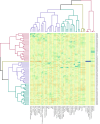Screening of native wild Salvia nemorosa populations for chemical compositions, antioxidant activity and UHPLC-HRMS profiling
- PMID: 39738427
- PMCID: PMC11685535
- DOI: 10.1038/s41598-024-83756-y
Screening of native wild Salvia nemorosa populations for chemical compositions, antioxidant activity and UHPLC-HRMS profiling
Abstract
In this study, screening of the collected 70 Salvia nemorosa L. populations from 54 habitats from West Azerbaijan province, Iran was evaluated by analyzing the content of phytochemical compounds, antioxidant activity, and UHPLC-HRMS profiling in different populations. The aerial parts of the plants were analyzed based on total phenolic (TPC) and flavonoid (TFC), total tannin (TTC), ascorbic acid (AAC), chlorophylls (Cla, and Clb), total carotenoid (TCC), β-carotene, antioxidant activity (by DPPH and FRAP assays), and 40 polyphenolic compounds by UHPLC-HRMS (phenolic acids, flavonoids and fatty acyl glicosides). Significant variations in phytochemical compositions and antioxidant activity were observed among S. nemorosa samples from different habitats. Rosmarinic acid, sagerinic acid, and caffeoylquinic acids (notable polyphenolic compounds with significant pharmacological properties, particularly in the context of their antioxidant, anti-inflammatory, and enzyme inhibitory activities) were identified as the major compounds in S. nemorosa populations. According to hierarchical cluster analysis (HCA) three groups of species were identified based on phytochemical compounds and antioxidant activity. Data analysis indicated that the quality and quantity of the chemical compounds, as well as their antioxidant functions, varied depending on habitat diversity. Overall, the results showed that each population exhibited a unique class of polyphenols, highlighting diverse potential applications across various industries. These findings suggest that the S. nemorosa populations studied here have significant potential for the development of innovative nutraceuticals, addressing the current scarcity of S. nemorosa-derived products in the market.
Keywords: Salvia nemorosa; Antioxidant; Flavonoids; Phenolic compounds; UHPLC-HRMS.
© 2024. The Author(s).
Conflict of interest statement
Declarations. Competing interests: The authors declare no competing interests.
Figures



Similar articles
-
Screening of 20 species from Lamiaceae family based on phytochemical analysis, antioxidant activity and HPLC profiling.Sci Rep. 2023 Oct 9;13(1):16987. doi: 10.1038/s41598-023-44337-7. Sci Rep. 2023. PMID: 37813985 Free PMC article.
-
Chemometrics-based analysis of the phytochemical profile and antioxidant activity of Salvia species from Iran.Sci Rep. 2024 Jul 27;14(1):17317. doi: 10.1038/s41598-024-68421-8. Sci Rep. 2024. PMID: 39068233 Free PMC article.
-
Phytochemical profiling, antioxidant potential, and UHPLC-HRMS analysis of Phlomis genus aerial parts for therapeutic applications.Sci Rep. 2025 Feb 25;15(1):6732. doi: 10.1038/s41598-025-89055-4. Sci Rep. 2025. PMID: 40000650 Free PMC article.
-
Chia Seeds (Salvia hispanica L.): An Overview-Phytochemical Profile, Isolation Methods, and Application.Molecules. 2019 Dec 18;25(1):11. doi: 10.3390/molecules25010011. Molecules. 2019. PMID: 31861466 Free PMC article. Review.
-
Exploring nutritional and bioactive properties of Maranta arundinacea L.: An unconventional food plant.Food Res Int. 2025 Jul;212:116462. doi: 10.1016/j.foodres.2025.116462. Epub 2025 Apr 23. Food Res Int. 2025. PMID: 40382045 Review.
References
-
- Esmaeili, G. H., Azizi, M., Arouiee, H. & Vaezi, J. Anatomical and morphological properties of trichomes in four Iranian native Salvia species under cultivated conditions. Int. J. Hortic. Sci.6, 189–200 (2019).
-
- Salvia nemorosa. Global Biodiversity Information Facility. Retrieved 6 February (2021).
-
- Betsy, C. & Barner, C. D. The New Book of Salvias216 (Timber, 2003).
-
- Ghafiyehsanj, E., Dilmaghani, K., Chaparzade, N. & Saadatmand, S. Comparative study on antioxidant activity of Salvia nemorosa L. from two different locations. South. Brazilian J. Chem.28, 17–21 (2020). (2020).
-
- Esmaeili, G. et al. Diversity of chemical composition and morphological traits of eight Iranian wild Salvia species during the first step of domestication. Agronomy12, 2455 (2022).
MeSH terms
Substances
LinkOut - more resources
Full Text Sources
Medical
Miscellaneous

